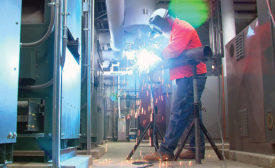Home » safety training
Articles Tagged with ''safety training''
Nearly half of businesses have closed temporarily due to weather in the past six months, says survey
Read More
Electric Arc Welding Safety
Preventing electrical shock should remain a top priority for your team at all times
Read More
May 29, 2015: MCAA, MSCA Revise Model NFPA 70E Electrical Safety Program for Service
Program Outlines Electrical Safety Procedures for Those Working on HVAC Equipment Pushing 480 Volts or Less
May 29, 2015
Feb. 16, 2015: Safety Professionals Call for Outcomes-Based Accreditation
Such Accreditation Can Assure More Effective Transfer of Required Knowledge, Skills, or Abilities/Behaviors
February 16, 2015
Sept. 4, 2014: New Guide Aids in Employee Safety Compliance
Guide Helps in Getting Problem Workers to Comply
September 4, 2014
Aug. 13, 2014: MCAA Releases Electric Arc Welding Safety Video
Training Video Illustrates the Importance of Following Safe Work Practices
August 13, 2014
Ice Breaker: Brazing and Soldering Procedures Need Care
Tips for Working Safely with Torches
Read More
Copyright ©2024. All Rights Reserved BNP Media.
Design, CMS, Hosting & Web Development :: ePublishing








